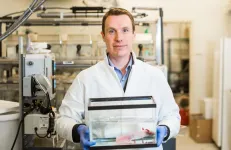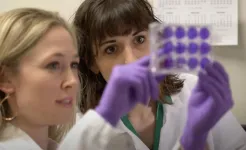Continuous glucose monitors help manage type 2 diabetes
Kaiser Permanente study finds monitors improve blood sugar control in selected insulin-treated patients.
2021-06-02
(Press-News.org) OAKLAND, Calif. -- In patients with insulin-treated type 2 diabetes, the use of continuous glucose monitors is associated with better blood sugar control and fewer visits to the emergency room for hypoglycemia, a Kaiser Permanente study published June 2 in the journal JAMA found.
The monitors have previously been shown to improve glucose control for patients with type 1 diabetes. Continuous glucose monitors are now the standard of care for these patients.
"The improvement in blood sugar control was comparable to what a patient might experience after starting a new diabetes medication," said the study's lead author Andrew J. Karter, PhD, a senior research scientist with the Kaiser Permanente Northern California Division of Research.
The retrospective, comparative effectiveness study included 5,673 patients with type 1 diabetes and 36,080 patients with type 2 diabetes treated with insulin who were self-monitoring their blood glucose. Between January 2015 and December 2019, on the recommendation of their doctors, 3,462 patients with type 1 diabetes and 344 with type 2 diabetes began using continuous glucose monitors.
Using statistical techniques that mimicked randomization in a clinical trial, the researchers evaluated before-and-after results among patients who initiated use of a continuous glucose monitor compared to the results among patients who did not. These analyses showed that continuous glucose monitors were associated with a decline in levels of HbA1c, a laboratory test used in the diagnosis and treatment of diabetes that measures blood sugar levels. The monitors also reduced emergency department visits and hospitalizations for hypoglycemia, or very low blood sugar. Hypoglycemia increases the risk for falls, cardiovascular disease, dementia, and death.
"Blood sugar levels that go too low can be dangerous," said the study's senior author Richard Dlott, MD, an endocrinologist and the medical director of population care for The Permanente Medical Group. "This study shows that continuous glucose monitors helped people stay close to their glucose targets without going too low."
For decades, people with diabetes have used finger sticks to test their blood sugar levels. Since 2017, Medicare has covered the cost of continuous glucose monitors for patients with diabetes who met certain qualifications. (Today, almost all people with type 1 diabetes qualify.) Continuous glucose monitors use a thin metallic sensor to detect blood sugar levels just under the skin. The sensor transmits blood sugar readings every 5 minutes to a receiver or smartphone. Continuous glucose monitors are available only with a prescription.
The study looked at patients with diabetes who started using continuous glucose monitors as prescribed by their doctor. To qualify under Medicare guidelines, a patient generally must give themselves 3 or more shots of insulin daily or use an insulin pump, perform blood glucose testing 4 or more times a day, and consistently communicate with a diabetes team every 3 to 6 months.
"Selective prescribing of continuous glucose monitors may partially explain the benefits we saw in these patients with type 2 diabetes," said Karter, who is also the associate director for the Health Delivery Systems Center for Diabetes Translational Research, sponsored by the National Institute of Diabetes and Digestive and Kidney Diseases. "Doctors appeared to have preferentially prescribed monitors to patients with a history of hypoglycemia or at high risk of hypoglycemia."
The next step, the researchers say, is to determine if there are other patients with type 2 diabetes whose blood sugar would be better and more safely controlled with continuous glucose monitors. "This study found that patients who used continuous glucose monitors had very good results compared to those who continued only with intermittent testing using finger sticks," said Dr. Dlott. "We now need to determine whether there are other patients who might also benefit, even if they don't meet all of the Medicare criteria. The newest technology isn't always better for everybody. We need to identify the people who are most likely to benefit."
INFORMATION:
The study was supported by an independent investigator award from Dexcom and funding from the National Institute of Diabetes and Digestive and Kidney Diseases. The sponsors had no role in the design or conduct of the study; collection, management, analysis, and interpretation of data; preparation, review, or approval of the manuscript; or in the decision to submit the manuscript for publication.
Co-authors include Melissa M. Parker, MS, and Howard H. Moffet, MPH, of the Division of Research, and Lisa K. Gilliam, MD, PhD, of The Permanente Medical Group.
About Kaiser Permanente
Kaiser Permanente is committed to helping shape the future of health care. We are recognized as one of America's leading health care providers and not-for-profit health plans. Founded in 1945, Kaiser Permanente has a mission to provide high-quality, affordable health care services and to improve the health of our members and the communities we serve. We currently serve 12.5 million members in 8 states and the District of Columbia. Care for members and patients is focused on their total health and guided by their personal Permanente Medical Group physicians, specialists, and team of caregivers. Our expert and caring medical teams are empowered and supported by industry-leading technology advances and tools for health promotion, disease prevention, state-of-the-art care delivery, and world-class chronic disease management. Kaiser Permanente is dedicated to care innovations, clinical research, health education, and the support of community health.
ELSE PRESS RELEASES FROM THIS DATE:
2021-06-02
What The Study Did: Researchers investigated the effect of real-time continuous glucose monitoring on glycemic control among patients with insulin-treated diabetes.
Authors: Andrew J. Karter, Ph.D., of Kaiser Permanente in Oakland, California, is the corresponding author.
To access the embargoed study: Visit our For The Media website at this link https://media.jamanetwork.com/
(doi:10.1001/jama.2021.6530)
Editor's Note: The article includes conflict of interest and funding/support disclosures. Please see the article for additional information, including other authors, author contributions and affiliations, conflict of interest and financial disclosures, and funding and support.
INFORMATION:
Media advisory: The full study and editorial ...
2021-06-02
BAR HARBOR, MAINE — Many salamanders can readily regenerate a lost limb, but adult mammals, including humans, cannot. Why this is the case is a scientific mystery that has fascinated observers of the natural world for thousands of years.
Now, a team of scientists led by James Godwin, Ph.D., of the MDI Biological Laboratory in Bar Harbor, Maine, has come a step closer to unraveling that mystery with the discovery of differences in molecular signaling that promote regeneration in the axolotl, a highly regenerative salamander, while blocking it in the adult mouse, which is a mammal with limited regenerative ability.
"Scientists at ...
2021-06-02
Researchers from Carnegie Mellon University's Computational Biology Department in the School of Computer Science have developed a new process that could reinvigorate the search for natural product drugs to treat cancers, viral infections and other ailments.
The machine learning algorithms developed by the Metabolomics and Metagenomics Lab match the signals of a microbe's metabolites with its genomic signals and identify which likely correspond to a natural product. Knowing that, researchers are better equipped to isolate the natural product to begin developing it for a possible drug.
"Natural products are still one of the most successful paths for drug discovery," said Bahar Behsaz, a project scientist in the lab and lead author of a paper about the process. "And ...
2021-06-02
A team of Colorado State University scientists, led by veterinary postdoctoral fellow Dr. Anna Fagre, has detected Zika virus RNA in free-ranging African bats. RNA, or ribonucleic acid, is a molecule that plays a central role in the function of genes.
According to Fagre, the new research is a first-ever in science. It also marks the first time scientists have published a study on the detection of Zika virus RNA in any free-ranging bat.
The findings have ecological implications and raise questions about how bats are exposed to Zika virus in nature. The study was recently published in Scientific Reports, a journal published by Nature Research.
Fagre, a researcher at CSU's Center for Vector-Borne Infectious Diseases, ...
2021-06-02
ITHACA, N.Y. - All fish are not created equal, at least when it comes to nutritional benefits.
This truth has important implications for how declining fish biodiversity can affect human nutrition, according to a computer modeling study led by Cornell and Columbia University researchers.
The study, "Declining Diversity of Wild-Caught Species Puts Dietary Nutrient Supplies at Risk," published May 28 in Science Advances, focused on the Loreto region of the Peruvian Amazon, where inland fisheries provide a critical source of nutrition for the 800,000 inhabitants.
At the same time, the findings apply to fish biodiversity worldwide, as more than 2 billion people depend on fish as their primary source of animal-derived nutrients.
"Investing in safeguarding biodiversity can deliver ...
2021-06-02
Researchers at Kyoto University's Institute for Cell-Material Sciences (iCeMS) have developed a new approach to speed up hydrogen atoms moving through a crystal lattice structure at lower temperatures. They reported their findings in the journal Science Advances.
"Improving hydrogen transport in solids could lead to more sustainable sources of energy," says Hiroshi Kageyama of iCeMS who led the study.
Negatively charged hydrogen 'anions' can move very quickly through a solid 'hydride' material, which consists of hydrogen atoms attached to other chemical elements. This system is a promising contender for clean energy, but the fast ...
2021-06-02
Stone tools have been made by humans and their ancestors for millions of years. For archaeologists these rocky remnants - lithic artefacts and flakes - are of key importance. Because of their high preservation potential they are among the most common findings in archaeological excavations. Worldwide, numerical dating of these lithic artefacts, especially when they occur as surface findings, remains a major challenge. Usually, stone tools cannot be dated directly, but only when they are embedded in sediment layers together with, for example, organic material. The age of such organic material can be constrained via the radiocarbon technique. If such datable organic remains are ...
2021-06-02
Tested on human blood in the lab, the selective nanocapsules could reduce the side effects of a major blood clot dissolving drug, which include bleeding on the brain. If confirmed with animal tests, the nanocapsules could also make the drug more effective at lower doses.
Blood clots, also known as thrombi, are a key cause of strokes and heart attacks which are leading causes of death and ill-health worldwide. They can be treated with a clot dissolving drug called tissue plasminogen activator (tPA) which disrupts clots to clear the blocked blood vessel and re-establish blood ...
2021-06-02
Known as nature's own sonar system, echolocation occurs when an animal emits a sound that bounces off objects in the environment, returning echoes that provide information about the surrounding space.
While echolocation is well known in whale or bat species, previous research has also indicated that some blind people may use click-based echolocation to judge spaces and improve their navigation skills.
Equipped with this knowledge, a team of researchers, led by Dr Lore Thaler, of Durham University, UK, delved into the factors that determine how people learn this skill.
Over the course of a 10-week training programme, the team investigated how blindness and age affect learning ...
2021-06-02
Atomically thin van der Waals magnets are widely seen as the ultimately compact media for future magnetic data storage and fast data processing. Controlling the magnetic state of these materials in real-time, however, has proven difficult. But now, an international team of researchers led by Delft University of Technology (TU Delft) has managed to use light in order to change the anisotropy of a van der Waals antiferromagnet on demand, paving the way to new, extremely efficient means of data storage.
The thin atomic layers that make up van der Waals magnets may seem extremely fragile, but they can be about 200 times stronger ...
LAST 30 PRESS RELEASES:
[Press-News.org] Continuous glucose monitors help manage type 2 diabetes
Kaiser Permanente study finds monitors improve blood sugar control in selected insulin-treated patients.




